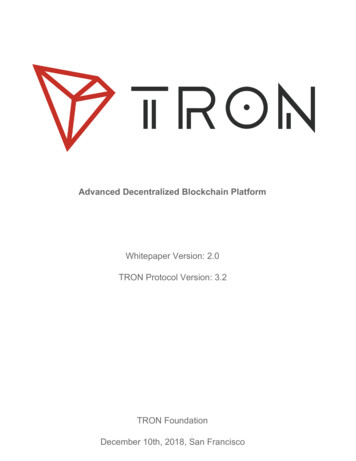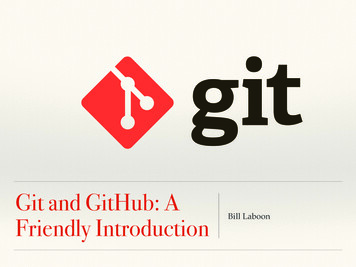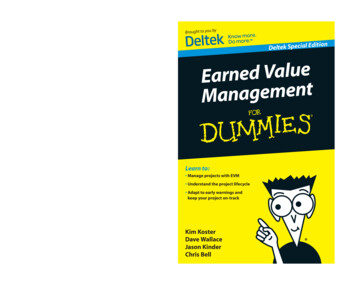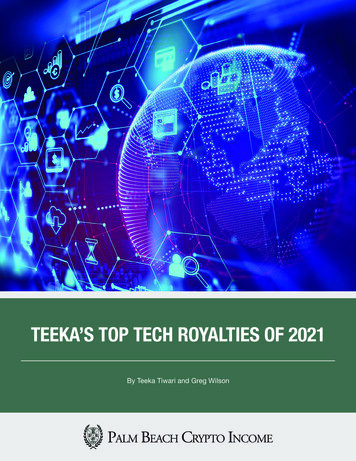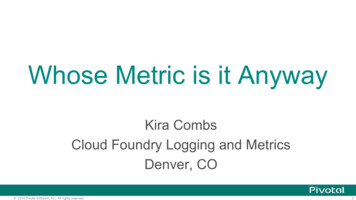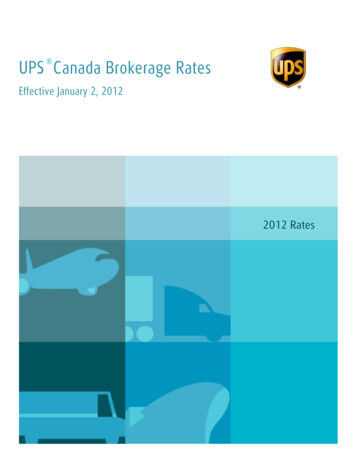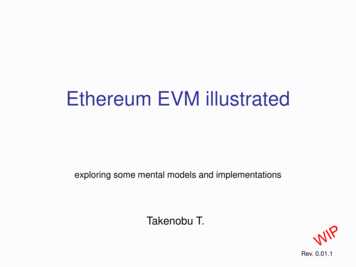
Transcription
Ethereum EVM illustratedexploring some mental models and implementationsTakenobu T.Rev. 0.01.1
NOTE- Please refer to the official documents in detail.- This information is current as of Mar, 2018.- Still work in progress.
Contents1. Introduction- Blockchain- World state- Account- Transaction- Message- Decentralised database- Atomicity and orderAppendix A : Implementation- Source code in Geth- EVM developer utility- Solidity ABI2. Virtual machine- Ethereum virtual machine (EVM)- Message call- Exception- Gas and fee- Input and output- Byte order- Instruction set- MiscellaneousAppendix C :- Markle tree and RLP- ConsensusAppendix B : User interface- Web3 API- Geth, Mist, Solc, Remix, Truffle, .References
1. Introduction
1. IntroductionBlockchain
A transaction-based state machineTransactionWorld statestWorld states t 1Ethereum can be viewed as a transaction-based state machine.References : [E1] Ch.2, [E3]
A transaction-based state machineTransactionWorld stateWorld statests t 1A transaction represents a valid arc between two states.References : [E1] Ch.2, [E3]
Block and transactionsBlockTransaction T1Transaction T2Transaction T3World statestWorld states t 1Transactions are collated into blocks.A block is a package of data.References : [E1] Ch.2, Ch.4, [E2], [E3]
Chain of statesBlock bBlock b 1Transaction T1Transaction T4Transaction T2Transaction T5Transaction T3Transaction T6World stateWorld stateWorld statests t 1s t 2From the viewpoint of the states,Ethereum can be seen as a state chain.References : [E1] Ch.2, Ch.4, [E2], [E3]
Chain of blocks: BlockchainBlock bBlock b 1Transaction T1Transaction T4Transaction T2Transaction T5Transaction T3Transaction T6World stateWorld stateWorld statests t 1s t 2From the viewpoint of the implementation,Ethereum can also be seen as a chain of blocks, so it is BLOCKCHAIN .References : [E1] Ch.2, Ch.4, [E2], [E3], [W3]
Stack of transactions : LedgerTransactionTransactionTransactionBlock b 1TransactionTransactionBlock ck 6TransactionTransactionTransactionBlock 5TransactionTransactionTransactionBlock 4TransactionTransactionTransactionBlock 3TransactionTransactionTransactionBlock 2Block actionGenesis blockFrom the viewpoint of the ledger,Ethereum can also be seen as a stack of transactions.References : [E1] Ch.2, Ch.4, [E2], [E3], [W3]
1. IntroductionWorld state
World stateWorld state s tAddress 1Account state 1Address 2Account state 2Address 3Account state 3::The world state is a mapping between address and account state.References : [E1] Ch.4, [E2]
Several views of world stateWorld stateAddress 1Account state 1Address 2Account state 2Address 3Account state 3::Mapping viewWorld stateTable viewAddress 1Account state 1Address 2Account state 2::Address nAccount state nWorld stateAccount 1Account 2Object view:Account nReferences : [E1] Ch.4
1. IntroductionAccount
AccountWorld stateAccount 1Account 2Account 3:An account is an object in the world state.References : [E1] Ch.4, [E2]
AccountWorld stateAccountAddress 1Account state 1Address 2Account state 2Address 3Account state 3::An account is a mapping between address and account state.References : [E1] Ch.4, [E2]
Account stateWorld stateAccountAccount stateAddressnoncebalancestorage hashcode hashAccount storageEVM codeAn account state could contain EVM code and storage.References : [E1] Ch.4
Two practical types of accountExternal actorWorld stateExternally owned account (EOA)Contract accountEVM codestorageAutonomous objectEOA is controlled by a private key.Contract account contains EVM code.References : [E1] Ch.4
Two practical types of accountExternal actorWorld stateExternally owned account (EOA)Contract accountAccount stateAddressnonceAccount stateAddressnoncebalancebalancestorage hashstorage hashcode hashcode hashstoragecodeEOA is controlled by a private key.EOA cannot contain EVM code.Contract contains EVM code.Contract is controlled by EVM code.References : [E1] Ch.4
Address of accountExternally owned account (EOA)Contract accountPrivate keySender addressNoncePublic keyRLP, KEC, right 160 bitshashAddressAddress160 bits160 bitsA 160-bit code used for identifying accounts.References : [E1] Ch.4, Ch.7, [E2]
1. IntroductionTransaction
A orld statestWorld states t 1A transaction is a single cryptographically-signed instruction.References : [E1] Ch.2, Ch.4, [E2]
A transaction to world stateExternal actor(a person or other entity)TransactionEthereum worldWorld stateA transaction is submitted by external actor.References : [E1] Appendix A
Two practical types of transactionExternal actorExternal actorContract creationMessage ld stateMessageEOAEOA or CAWorld stateThere are two practical types of transaction, contract creation and message call.References : [E1] Ch.4
Contract creationTransactioninit codeAddress 1Account state 1Address 1Account state 1Address 2Account state 2Address 2Account state 2::::Address NAccount state NcodeWorld stateststorageWorld state s t 1References : [E1] Ch.7
Message callTransactioninput dataAddress 1Account state 1Address 1Account state 1Address 2Account state 2Address 2Account state 2::::Address NAccount state NAddress NAccount state NcodeWorld stateststoragecodestorageWorld state s t 1References : [E1] Ch.7
Field of a transactionTransactionnoncegasPricegasLimit160 bits address or 0 if contract creationtovaluetransferred wei (ether)v, r, sinit or datacontract creation or message callReferences : [E1] Ch.4
1. IntroductionMessage
MessageWorld stateAccount AAccount BMessageMessage is passed between two Accounts.Message is Data (as a set of bytes) and Value (specified as Ether) .References : [E1] Ch.8, Appendix A
MessageTriggered by transactionTriggered by EVM sageAccountEVM codeWorld stateTransaction triggers an associated message.World stateEVM can also send a message.References : [E1] Ch.8
Four cases of messageBy Transaction From EOABy EVM code From CATransactionMessageEOAEOAEOATo EOACAMessagecodeTransactionEOAMessageTo CAMessageCACAcodeCAReferences : [E1] Ch.8
1. IntroductionDecentralised database
Globally shared, transactional databaseWorld stateA blockchain is a globally shared, transactional database.References : [E3], [E7] Ch.7
Decentralised databaseWorld stateWorld stateWorld stateP2PnetworkWorld stateWorld stateWorld stateWorld stateWorld stateA blockchain is a globally shared, decentralised, transactional database.References : [E3], [E7] Ch.7
P2P network inter nodesEthereumnodeEthereumnodeWorld stateWorld stateEthereumnode.World stateP2PDecentralised nodes constitute Ethereum P2P network.References : [E3],
Interface to a nodeExternalactorContract creationMessage callTransactionTransactionInspectionInterface (Web3 API)EthereumworldWorld stateEthereum node (Geth, Parity, .)External actors access the Ethereum world through Ethereum nodes.References : [E1] Appendix A, Ch.4, Ch.7, Ch.8
1. IntroductionAtomicity and order
Atomicity of transactionTransactionA transaction is an atomic operation. Can't divide or interrupt.TransactionorTransactionThat is, All (complete done) or Nothing (zero effect).
Order of transactionsorder nTransactionTransactions cannot be overlapped.Transactions must be executed sequentially.
Order of transactionsExternal actor A3rd submittedTransactionExternal actor B1st submittedTransaction2nd submittedTransactionorder inTransaction order is not guaranteed.?
Ordering inner blocksendersendersenderTransaction BTransaction CTransaction ATransaction ATransaction CTransactionpoolTransaction Bdeterminedby minerTransaction CTransaction AorderedTransaction BBlockMiner can determine the order of transactions in a block.
Ordering inter blocksWinnerminerminerminer(Block b 2)(Block b 2)(Block b 2)Transaction CTransaction BTransaction ATransaction ATransaction DTransaction ETransaction BTransaction ATransaction Cfastselected by PoWTransaction T1Transaction T4Transaction T2Transaction T5Transaction T3Transaction T6Block bBlock b 1The order between blocks is determined by a consensus algorithm such as PoW.References : [E1] Ch.2, Ch.4
2. Virtual machine
2. Virtual machineEthereum virtual machine (EVM)
Ethereum virtual machineTransaction of message callinput dataWorld stateAddress NstWorld state s t 1Address NAccount state NcodestorageAccount state NcodestorageEVM(Ethereum Virtual Machine)EVM code is executed on Ethereum Virtual Machine (EVM).References : [E1] Ch.9, Appendix H
Ethereum virtual machineCodeVirtual machineEVM codeEVM (Ethereum Virtual Machine)The Ethereum Virtual Machine is the runtime environment for smart contracts in Ethreum.References : [E1] Ch.9, Appendix H, [E4], [W1]
EVM architectureEthereum Virtual Machine (EVM)Virtual ROMEVM code(immutable)Program counterStackMemory(Account) storagePCGas availableGasMachine state mWorld state s(volatile)(persistent)The EVM is a simple stack-based architecture.References : [E1] Ch.9, Appendix H, [E4]
Machine space of EVMRegistersStackMemory(Account) storage-stack memoryvolatile memorypersistent memory256 bits x 1024 elementsbyte addressinglinear memory256 bits to 256 bitskey-value storeThere are several resources as space.References : [E1] Ch.9, Appendix H, [E3], [E7], [W2]
StackStack256-bit read/write:operation with 16 elementsin stack top:1024 elements256 bitsAll operation are performed on the stack.Access with many instructions such as PUSH/POP/COPY/SWAP, .References : [E1] Ch.9, Appendix H, [E7], [W2]
MemoryMemory256-bit load:256-bit storeor8-bit store8 bitsMemory is linear and can be addressed at byte level.Access with MSTORE/MSTORE8/MLOAD instructions.All locations in memory are well-defined initially as zero.References : [E1] Ch.9, Appendix H, [E7], [W2]
Account storage(Account) storage256-bit load/storeKey 1Value 1Key2Value 2::Key nValue n256 bits256 bitsStorage is a key-value store that maps 256-bit words to 256-bit words.Access with SSTORE/SLOAD instructions.All locations in storage are well-defined initially as zero.References : [E1] Ch.9, Appendix H, [E7], [W2]
EVM codeAssembly viewPUSH1 e0PUSH1 02EXPPUSH1 00CALLDATALOAD:Bytecode view0x60e060020a600035.EVM Code is the bytecode that the EVM can natively execute.References : [E1] Ch.9, Appendix H
Execution modelEVMEVM codeinstructionsStackPCoperationsMemorystack top(Account) storagerandomaccessGas availrandomaccesspush/pop/.References : [E1] Ch.9, Appendix H
2. Virtual machineMessage call
Message callWorld stateEOAContract accountMessageEVM codeContract accountMessageEVM codeEVM can send a message to other account.The depth of message call is limited to less than 1024 levels.References : [E1] Ch.8, Appendix A
Instructions for Message callinput dataStackMemoryStackMemoryargumentsCALL instructionreturn valueEVMRETURN instructionEVMMessage call is triggered by CALL instruction.Arguments and return values are passed using memory.References : [E1] Ch.8, Ch.9
2. Virtual machineException
ExceptionTransactioninput dataWorld stateAddress NstWorld state s t 1Address NAccount state NAccount state NThe behavior if an exception occurs is subtle. [E9]code storagecodestorageExceptionEVMToDo: Refine this pageIf an exception occurs in the EVM, the state is not updated.References : [E9], [E1] Ch.9, Appendix H
ExceptionEVMinvalidjump destinationEVM codeinvalidinstructionStackPCMemoryoperationsGas availStorageout-of-gasstack underflowReferences : [E1] Ch.9, Appendix H
2. Virtual machineGas and fee
Gas and feeMessage callTransactionWorld stateEOAGas supplyMessageContract accountRefundGasEVM codeAll programmable computation in Ethereum is subject to fees (denominated in gas).References : [E1] Ch.5, Ch.9, Appendix G
GasEVMEVM codeMessage callStackPCGas ences : [E1] Ch.5, Ch.9, Appendix G
2. Virtual machineInput and output
Input and Output of EVMExternalactorTransactioninput datalogMessage callEVMEVMreturn valueEVM can input external data from a message call.EVM can output log. EVM can also return values to Caller EVM.References : [E1] Ch.9, Appendix H
Instructions for input datainput es : [E1] Ch.7, Ch.9
2. Virtual machineByte order
Endian for Memoryaddress (byte addressing)N N 1Memory.N 31.256-bit load (MLOAD)256-bit store (MSTORE)MSBLSBStackEVM is big endian order (network byte order).References : [E1] Ch.9, Appendix H, [E7], [W2]
Endian for Memoryaddress (byte addressing)NMemory8-bit store (MSTORE8)MSBLSBStackEVM is big endian order (network byte order).References : [E1] Ch.9, Appendix H, [E7], [W2]
Endian for input dataaddress (byte addressing)N N 1input data.N 31.CALLDATALOAD or CALLDATACOPYMSBLSBStackorMemoryEVM is big endian order (network byte order).References : [E1] Ch.9, Appendix H, [E7], [W2]
Byte order of BYTE and SIGNEXTEND instructionNth byte0.131.StackMSBLSBBYTE instruction counts from MSB.Nth byte.3110.StackMSBLSBSIGNEXTEND instruction counts from LSB.References : [E1] Ch.9, Appendix H, [E7], [W2]
Byte order of PUSH instructionsNth byte.31PUSH1 0x011.Stack001MSBright-aligned, big endianLSBNth byte.31PUSH4 0x01020304.Stack1001 02 03 04MSBright-aligned, big endianLSBNth byte31PUSH32 0x0102.1f20Stack.1001 02 . 1b 1c 1d 1e 1f 20MSBLSBright-aligned, big endianReferences : [E1] Ch.9, Appendix H, [E7], [W2]
2. Virtual machineInstruction set
Instruction set* Basically, 256-bit operation.* Contract creation and destruct* CREATE, DELEGATECALL* Hash* SHA3* Shift operation* using MUL or DIV, SDIV* Div operation* without zero divisional exception* .References : [E1] Ch.9, Appendix H
Copy of code and input datainput dataCALLDATALOADCALLDATACOPYEVM codeEVM codeStackMemoryCODECOPYEXTCODECOPYEVMEVMThere are several copy instructions for inter spaces.References : [E1] Ch.8, Ch.9
Shift by MUL, DIV and SDIVLeft shiftMSBLSBStackMUL m (2 n) m nLeft shift is represented by MUL instruction.Right shiftMSBStackLSBDIV m (2 n) m nDIV for logical right shiftSDIV for arithmetic right shiftRight shift is represented by DIV and SDIV instruction.References : [E1] Ch.9, Appendix H, [E7], [W2]
2. Virtual machineMiscellaneous
EVM code generationSolidity sourceSolidity compilerViper sourceViper compilerLLL sourceLLL compilerEVM codeEthereum virtual machine codeReferences : [E7]
Ethereum virtual machine layercodevirtual machineruntime system(process)EVM codeEVMEthereum Virtual MachineEthereum node(Geth, Parity, .)softwarehardwarePhysical Processor(x86, ARM, .)References : [E1] Ch.9
eWASMThe eWASM is next generation VM.
Appendix A
Appendix ASource code in Geth
Block header(go-ethereum version 1.8)[core/types/block.go]type Header struct estNonce}Block 64uint64*big.Int[]bytecommon.HashBlockNonce json:"parentHash" json:"sha3Uncles" json:"miner" json:"stateRoot" json:"transactionsRoot" json:"receiptsRoot" json:"logsBloom" json:"difficulty" json:"number" json:"gasLimit" json:"gasUsed" json:"timestamp" json:"extraData" json:"mixHash" json:"nonce"gencodec:"required" gencodec:"required" Root of Stategencodec:"required" gencodec:"required" gencodec:"required" gencodec:"required" Root of Transactiongencodec:"required" gencodec:"required" gencodec:"required" gencodec:"required" gencodec:"required" gencodec:"required" gencodec:"required" gencodec:"required" gencodec:"required" References : [C1]
Transaction(go-ethereum version 1.8)[core/types/transaction.go]type txdata struct nt[]byte json:"nonce"gencodec:"required" json:"gasPrice" gencodec:"required" to address json:"gas"gencodec:"required" json:"to"rlp:"nil" // nil means contract creation json:"value"gencodec:"required" value (Wei) json:"input"gencodec:"required" // Signature valuesV *big.Int json:"v" gencodec:"required" R *big.Int json:"r" gencodec:"required" S *big.Int json:"s" gencodec:"required" input data// This is only used when marshaling to JSON.Hash *common.Hash json:"hash" rlp:"-" }References : [C1]
World state(go-ethereum version 1.8)[core/state/statedb.go]type StateDB struct {dbDatabasetrie TrieWorld ateObjectsDirty map[common.Address]struct{}Mapping forAddress to Account statedbErr errorrefund uint64thash, sh][]*types.Loguintpreimages map[common.Hash][]byte:References : [C1]
Account object (state object)(go-ethereum version 1.8)[core/state/state object.go]type stateObject struct {address common.AddressaddrHash common.HashdataAccountdb*StateDBAddressAccount statedbErr errortrie Trie // storage trie, which becomes non-nil on first accesscode Code // contract bytecode, which gets set when code is loadedcachedStorage Storage // Storage entry cache to avoid duplicate readsdirtyStorage Storage // Storage entries that need to be flushed to diskdirtyCodesuicidedtoucheddeletedonDirtybool // true if the code was updatedboolboolboolfunc(addr common.Address)}References : [C1]
Account state, Code and Storage(go-ethereum version 1.8)[core/state/state object.go]type Account struct {Account stateNonceuint64Balance *big.IntRootcommon.Hash // merkle root of the storage trieCodeHash []byte}type Code []bytetype Storage map[common.Hash]common.HashEVM codeAccount storageReferences : [C1]
Stack and Memory(go-ethereum version 1.8)[core/vm/stack.go]type Stack struct {data []*big.Int}Stackfunc newstack() *Stack {return &Stack{data: make([]*big.Int, 0, 1024)}}[core/vm/memory.go]type Memory struct {store[]bytelastGasCost uint64}Memoryfunc NewMemory() *Memory {return &Memory{}}References : [C1]
Instruction operation (arithmetic and stack)(go-ethereum version 1.8)[core/vm/instruction.go]Arithmetic operationfunc opAdd(pc *uint64, evm *EVM, contract *Contract, memory *Memory, stack *Stack)([]byte, error) {x, y : stack.pop(), stack.pop()stack.push(math.U256(x.Add(x, y)))evm.interpreter.intPool.put(y)return nil, nil}Stack operationfunc opPop(pc *uint64, evm *EVM, contract *Contract, memory *Memory, stack *Stack)([]byte, error) {evm.interpreter.intPool.put(stack.pop())return nil, nil}References : [C1]
Instruction operation (memory and storage)(go-ethereum version 1.8)[core/vm/instruction.go]Memory operationfunc opMload(pc *uint64, evm *EVM, contract *Contract, memory *Memory, stack*Stack) ([]byte, error) {offset : stack.pop()val : new(big.Int).SetBytes(memory.Get(offset.Int64(), set)return nil, nil}Storage operationfunc opSload(pc *uint64, evm *EVM, contract *Contract, memory *Memory, stack*Stack) ([]byte, error) {loc : common.BigToHash(stack.pop())val : evm.StateDB.GetState(contract.Address(), loc).Big()stack.push(val)return nil, nil}References : [C1]
Instruction operation (call)(go-ethereum version 1.8)[core/vm/instruction.go]Flow operationfunc opCall(pc *uint64, evm *EVM, contract *Contract, memory *Memory, stack *Stack)([]byte, error) {// Pop gas. The actual gas in in pop())gas : evm.callGasTemp// Pop other call parameters.addr, value, inOffset, inSize, retOffset, retSize : stack.pop(),stack.pop(), stack.pop(), stack.pop(), stack.pop(), stack.pop()toAddr : common.BigToAddress(addr)value math.U256(value)// Get the arguments from the memory.args : memory.Get(inOffset.Int64(), inSize.Int64())if value.Sign() ! 0 {gas params.CallStipend}ret, returnGas, err : evm.Call(contract, toAddr, args, gas, value)if err ! nil {:References : [C1]
Gas(go-ethereum version 1.8)[core/vm/gas.go]const int64 23581020GbaseGverylowGasReturnuint64 0GasStopuint64 0GasContractByte uint64 200)[core/vm/gas table.go]func gasSStore(gt params.GasTable, evm *EVM, contract *Contract, stack *Stack, mem*Memory, memorySize uint64) (uint64, error) {var (y, x stack.Back(1), stack.Back(0)val s : [C1]
Interpreter(go-ethereum version 1.8)[core/vm/interpreter.go]func (in *Interpreter) Run(contract *Contract, input []byte) (ret []byte, errerror) {// Increment the call depth which is restricted to 1024in.evm.depth defer func() { in.evm.depth-- }()increment call depthin.returnData nilif len(contract.Code) 0 {return nil, nil}codehash : contract.CodeHash // codehash is used when doing jump dest cachingif codehash (common.Hash{}) {codehash crypto.Keccak256Hash(contract.Code)}var (opOpCode// current opcodemem NewMemory() // bound memorystack newstack() // local stackcreate Memorycreate Stack:References : [C1]
ApplyTransaction(go-ethereum version 1.8)[core/state processor.go]func ApplyTransaction(config *params.ChainConfig, bc *BlockChain, author*common.Address, gp *GasPool, statedb *state.StateDB, header *types.Header, tx*types.Transaction, usedGas *uint64, cfg vm.Config) (*types.Receipt, uint64, error){msg, err : tx.AsMessage(types.MakeSigner(config, header.Number))if err ! nil {return nil, 0, err}// Create a new context to be used in the EVM environmentcontext : NewEVMContext(msg, header, bc, author)// Create a new environment which holds all relevant information// about the transaction and calling mechanisms.create EVMvmenv : vm.NewEVM(context, statedb, config, cfg)// Apply the transaction to the current state (included in the env), gas, failed, err : ApplyMessage(vmenv, msg, gp)if err ! nil {return nil, 0, err}// Update the state with pending changesvar root []byteif config.IsByzantium(header.Number) {:References : [C1]
Version of EVM instruction set(go-ethereum version 1.8)[core/vm/interpreter.go]func NewInterpreter(evm *EVM, cfg Config) *Interpreter {if !cfg.JumpTable[STOP].valid {switch {case .JumpTable byzantiumInstructionSetcase .JumpTable homesteadInstructionSetdefault:cfg.JumpTable frontierInstructionSet:added instructions:STATICCALL, RETURNDATASIZE,RETURNDATACOPY and REVERTadded instruction:DELEGATECALL[core/config.go]var (MainnetChainConfig &ChainConfig{ChainId:big.NewInt(1),HomesteadBlock: 0),DAOForkSupport: true,EIP150Block:big.NewInt(2463000),EIP150Hash: EIP158Block:big.NewInt(2675000),ByzantiumBlock: big.NewInt(4370000),:References : [C1]
Bootstrap of EVM in Geth(go-ethereum version 1.8):ApplyTransaction [core/state processor.go]create EVMApplyMessage [core/state transaction.go]TransactionDb [core/state transaction.go]Call [core/vm/evm.go]run [core/vm/evm.go]Run [core/vm/interpreter.go]create Memorycreate StackReferences : [C1]
Appendix AEVM developer utility
Example of evm command(go-ethereum version 1.8)The go-ethereum project provides evm utility command.Compile EVM assembly code cat sample.asmpush 0x1push 0x2add evm compile sample.asm6001600201Disassemble EVM bytecode cat sample.bin6001600201 evm disasm sample.bin000000: PUSH1 0x01000002: PUSH1 0x02000004: ADDReferences : [C1]
Example of evm command(go-ethereum version 1.8)Run EVM assembly code evm --debug run sample.asm#### TRACE ####PUSH1pc 00000000 gas 10000000000 cost tack:00000000pc 00000002 gas 9999999997 cost 000000000000001pc 00000004 gas 9999999994 cost 00000000000000000000000000001pc 00000005 gas 9999999991 cost 000000000000003#### LOGS ####References : [C1]
Appendix ASolidity ABI
Solidity Application Binary InterfaceFunction selector(SHA-3 hash)input dataArguments, dispatchingJUMPIfunction Afunction BEVM codeStack or MemoryEVMReferences : [E7]. Ch.7, [E1] Ch.9, Appendix H, [W4], [W2]
Appendix B
Appendix BWeb3 API
Web3 API and clientCLIWalletWalletIDEIDE / ntWeb3 APIEthereumnetworkWorld stateEthereum clients access to Ethereum network via Web3 API.References : [E8], [C1], [C3], [C4], [C5], [C6]
Web3 API and clientEthereumclientGeth console,Mist, MetaMask,Remix, Truffle, .Web3 APIEthereumnetworkEthereumnodeEthereumnode(Geth, Parity, .)(Geth, Parity, .).Ethereumnode(Geth, Parity, .)P2PEthereum clients access to Ethereum network via Web3 API.References : [E8], [C1], [C3], [C4], [C5], [C6]
Appendix BGeth, Mist, Solc, Remix, Truffle, .
GethGethconsoleEthereumclientWeb3 APInodeWeb3 I/FEthereumnetworkEVM.EthereumnodeP2P(Geth, Parity, .)P2PReferences : [C1]
MistMistEthereumclientprivate keyWeb3 APIEthereumnetworkEthereumnode(Geth, Parity, .)References : [C3]
SolcSolidity sourceSolc(Solidity compiler)EVM code(Geth, Mist, Truffle, .)Web3 APIEthereumnetworkEthereumnode(Geth, Parity, .)References : [C2]
3Web3providerMetaMaskWeb3 APIEthereumnetworkReferences : [C5]
TruffleTruffleEthereumclientconsoleWeb3 APIEthereumnetworkPrivate chainEthereumnode(Geth, Parity, .)P2PReferences : [C6]
References
References[E1]Ethereum Yellow PaperETHEREUM: A SECURE DECENTRALISED GENERALISED TRANSACTION iki/Glossary[E3]White PaperA Next-Generation Smart Contract and Decentralized Application e-Paper[E4]Design ign-Rationale[E5]Ethereum Development reum-Development-Tutorial[E6]Ethereum Ethereum-introduction[E7]Solidity docs.io/en/develop/[E8]Web3 JavaScript app API for ript-API[E9]ethereum/wiki btleties#exceptional-conditions
References[W1] Awesome Ethereum Virtual m-virtual-machine[W2] Diving Into The Ethereum m-6e8d5d2f3c30[W3] Stack Exchange: Ethereum block stions/268/ethereum-block-architecture/6413[W4] Porosity-Decompiling-Ethereum-Smart-Contracts.pdf
References[C1]Go ]Solc (Solidity ist (Ethereum [C6]Trufflehttps://github.com/trufflesuite/truffle
Ethereum EVM illustrated Takenobu T. Rev
